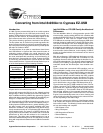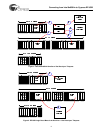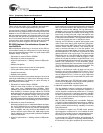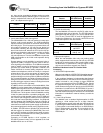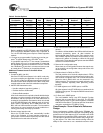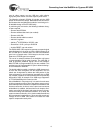
Converting from Intel 8x930Ax to Cypress EZ-USB
4
tus, they can be expanded to 64-byte maximum packet
sizes, which will improve USB throughput. For isochronous
designs, endpoints will need to be converted from end-
point 1 to endpoints 8 through 15.
5. Lower power/Easier power management
The Intel 8x930Ax has a 150-mA maximum current spec-
ification under normal operation. The USB specification
requires a device to consume no more than 100 mA during
the initial plug-in. This is because bus-powered hubs can
only supply a maximum of 100 mA per port during bus
enumeration. Following the chip reset, the 8x930Ax oper-
ates in low-clock mode, wherein the CPU and on-chip pe-
ripherals are clocked at a reduced rate until bus enumera-
tion is complete. This reduces the I
CC
to meet the USB
100-mA requirement. Thus the Intel 8x930Ax requires the
USB microcontroller to be in idle mode operation during
initial power-on.
Remote wake-up on the 8x930Ax is performed using a
register bit (RWU). Firmware must be used to drive re-
sume signaling on the USB lines. The USB microcontroller
must be awake in order for firmware to be accessed and
generate the remote wake-up operation. However, this
makes it difficult for remote activity peripherals such as
modems and telephones, which are usually in a suspend-
ed state when not in use to save power. An external stim-
ulus, such as a phone call, requires careful timing by the
peripheral designer as it must pull the USB microcontroller
out of suspend operation and write to firmware before ini-
tiating the next series of events. Normally, an external stim-
ulus should trigger a series of events, including the resume
signalling in the host PC right away.
In addition, there is a restriction on the Intel 8x930Ax. If the
8x930Ax is put into power-down mode prior to receiving a
USB Suspend signal from the host, a USB Resume will not
properly wake up the 8x930Ax from the power-down mode.
EZ-USB uses ¼ of the power of the Intel 8x930Ax, making
it ideal for power-sensitive or portable peripherals. As a
result, there is no idle operation mode, since EZ-USB only
has a 50-mA (25-mA typical) maximum current specifica-
tion under the normal operating conditions. If a peripheral
requires between 500 and 600 mA, then the reduction of
100 mA by switching to EZ-USB will allow the peripheral
manufacturer to eliminate the power supply and become a
bus-powered peripheral, thereby saving significant costs.
In addition, EZ-USB resume operation can be performed
with the toggle of an external pin (WAKEUP#), thus mak-
ing it easy for hardware to implement the wake-up opera-
tion. No timing considerations due to waking the USB mi-
crocontroller are necessary.
Converting to EZ-USB requires a 3.3V regulator, as
EZ-USB is powered under 3.3V as opposed to the Intel
8x930Ax which can run off Vbus.
6. Smaller board density
The Intel 8x930Ax is housed in a 68 PLCC, which has an
approximate body size of 24 x 24. The EZ-USB family is
packaged in both the 44 PQFP (10 x 10 mm) and 80 PQFP
(14 x 10 mm). The 44 PQFP is useful for applications not
needing the address bus. As a result, a 44 PQFP can use
¼ the board space of the Intel solution.
7. More product options
While the Intel 8x930Ax offers only one product option
which supports both isochronous and bulk, the EZ-USB
family has 10 product options. All the options differ in inter-
nal RAM size, I/O performance, and the support of bulk
only versus isochronous support (see Table 2).
Additional Hardware Issues To Consider When
Converting
8. VID/PID/DID Implementation
With the Intel 8x930Ax, VID/PID/DID information was em-
bodied into the internal ROM or external ROM/EPROM.
If the peripheral designer is implementing the firmware
download feature of EZ-USB, then the VID/PID/DID infor-
mation is housed in a tiny 16-byte (or larger) EEPROM
which is connected through the EZ-USB I
2
C port. Should
the peripheral designer use an 8K EEPROM to load the
entire firmware through the I
2
C port, then the VID/PID/DID
information is contained in the 8K EEPROM. Of course, if
the peripheral designer requires more than 8K of firmware
and uses external memory for firmware, the VID/PID/DID
information is embodied in external memory as with the
8x930Ax.
9. 1.5-kΩ Pull-up Resistor
The 8x930Ax uses a standard implementation for USB,
attaching a 1.5-kΩ resistor from D+ to Vbus. However,
EZ-USB performs special tricks with the USB signal lines
in performing the ReNumeration operation. As a result, the
1.5-kΩ resistor is connected directly to our DISCON# pin.
Even if ReNumeration operation is not required, the de-
signer should still connect the 1.5-kΩ resistor to the
DISCON# pin.
Feature
Cypress
EZ-USB Family
Intel
8x930Ax
Endpoint Pairs 16 4/6
Max. Packet Size
Isochronous (bytes) 1024 512/256
Bulk (bytes) 64 16/32
Feature
Cypress
EZ-USB Family
Intel
8x930Ax
Voltage (volts) 3.0–3.6 4.0–5.25
Max. Power (Active) 180 mW 788 mW
Max. Current (Active) 50 mA 150 mA
Feature
Cypress
EZ-USB Family
Intel
8x930Ax
Package 44 PQFP
80 PQFP
68 PLCC
Package Board
Density
170 sq. mm
432 sq. mm
625 sq. mm



